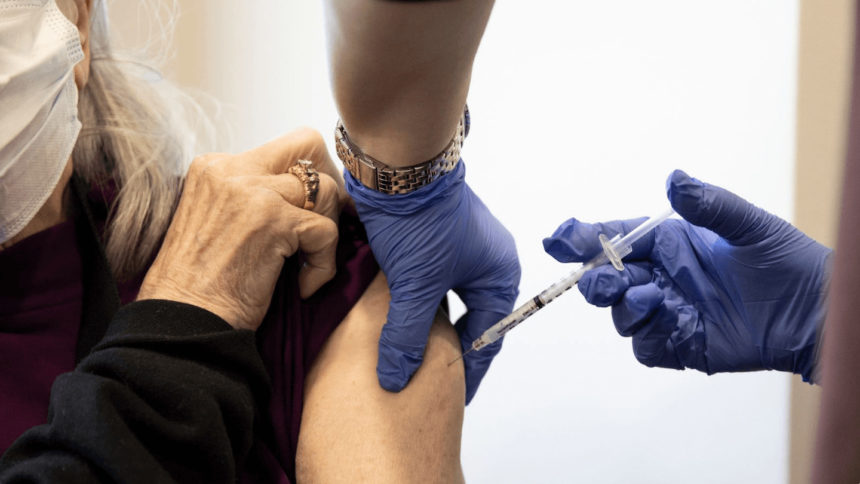
A Civitas Senior Living staff member receives her COVID-19 vaccination. (Photo courtesy of Civitas Senior Living)
U.S. companies employing 100 or more workers must develop, implement and enforce a mandatory COVID-19 vaccination policy, unless they adopt a policy requiring employees to choose to either be vaccinated or undergo regular COVID-19 testing and wear a face covering at work, under an emergency temporary standard issued by the Department of Labor’s Occupational Safety and Health Administration today.
“Businesses that don’t comply may face significant OSHA fines,” the Labor Department said. Employers found to be non-compliant may face a $14,000 penalty for a single citation. That penalty will jump to $140,000 for “willful penalties.”
The standard, which OSHA said could become permanent and include smaller employers, is set to be published in the Federal Register tomorrow but is available now as a PDF. Employers must comply with most requirements within 30 days of publication and with testing requirements within 60 days of publication. Senior administration officials said that employers will need to ensure that their employees have received their final vaccination doses by Jan. 4, with at least weekly testing required for unvaccinated employees after that.
“COVID-19 has had a devastating impact on workers, and we continue to see dangerous levels of cases,” Labor Secretary Marty Walsh said in a statement. “We must take action to implement this emergency temporary standard to contain the virus and protect people in the workplace against the grave danger of COVID-19. Many businesses understand the benefits of having their workers vaccinated against COVID-19, and we expect many will be pleased to see this OSHA rule go into effect.”
The emergency temporary standard covers employers with 100 or more employees — firm or company-wide — and provides options for compliance. OSHA said that approximately 84 million workers will be covered. It also requires employers to provide paid time to workers to get vaccinated and to allow for paid leave to recover from any side effects. It comes on the same day that the Centers for Medicare & Medicaid Services issued an emergency regulation requiring long-term care and other healthcare facilities that participate in the Medicare and Medicaid programs to develop COVID-19 vaccination policies for their workers by Dec. 5; under that emergency regulation, all eligible workers must be fully vaccinated by Jan. 4.
| CMS issues reg requiring COVID-19 vaccination for long-term care workers |
Imminent release of the rule from OSHA was expected as of early this week; a Department of Labor spokesperson told McKnight’s on Monday that publication would happen “in the coming days,” relaying that the White House Office of Management and Budget had completed its regulatory review. OSHA also developed the standard at the request of President Biden, who included it in his six-point COVID-19 action plan announced Sept. 9.
The Labor Department said that the standard will cover two-thirds of the nation’s private-sector workforce. In the 26 states and two territories with OSHA state plans, the standard also will cover public sector workers employed by state and local governments, including educators and school staff.
The emergency temporary standard requires employers to:
- Determine the vaccination status of each employee, obtain acceptable proof of vaccination status from vaccinated employees and maintain records and a roster of each employee’s vaccination status.
- Require employees to provide prompt notice when they test positive for COVID-19 or receive a COVID-19 diagnosis. Employers then must remove the employee from the workplace, regardless of vaccination status; employers must not allow them to return to work until they meet required criteria.
- Ensure that each worker who is not fully vaccinated is tested for COVID-19 at least weekly (if the worker is in the workplace at least once a week) or within 7 days before returning to work (if the worker is away from the workplace for a week or longer).
- Ensure that, in most circumstances, each employee who has not been fully vaccinated wears a face covering when indoors or when occupying a vehicle with another person for work purposes.
The emergency temporary standard does not require employers to pay for testing, although employers may be required to pay for testing to comply with other laws, regulations, collective bargaining agreements, or other collectively negotiated agreements, the Labor Department said. Employers also are not required to pay for face coverings.
OSHA is offering compliance assistance to help businesses implement the standard, including a webinar, frequently asked questions and other materials.
The emergency temporary standard also serves as a proposal for normal rulemaking for a final standard. OSHA is seeking comment as to whether the agency should adopt it as a final standard.



